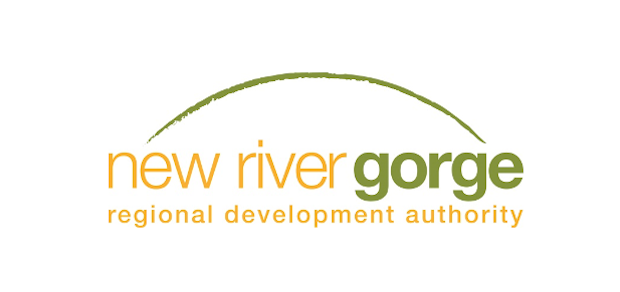Goals explained at Regional Economic Development Summit
By Autumn Shelton, West Virginia Press Association
BECKLEY, W.Va. – Economic development isn’t something that happens overnight. It can take years – if not decades – before sustainable growth is achieved. But that long-term growth is something that members of the New River Gorge Regional Development Authority (NRGRDA) say they are more than ready to achieve in southern West Virginia.
The NRGRDA recently hosted the Regional Economic Development Summit at the historic Black Knight Country Club in Beckley.
During the event, NRGRDA Director Jina Belcher said that as the state’s largest regional development authority, she and her team face specific challenges in the four counties they serve (Nicholas, Fayette, Raleigh and Summers). However, through a set of core values and work priorities they endeavor to keep the area’s economic growth moving in the right direction.
“At the end of the day, our goal is to recruit and retain jobs regardless of what that looks like,” Belcher said. “We have to ensure that we are maintaining that purpose through all of the work we do.”
According to Dr. John Deskins, Director of the West Virginia University Bureau of Business and Economic Development, the region’s economy “has faced significant turmoil over the last decade,” and the pandemic did not help.
Data shows that the region is forecasted to “rebound at a below-average pace and is not expected to recover fully from the Covid-19 recession” in the next five years. Regional employment is expected to grow at a rate of just 0.2 percent in that same period.
Several factors are at play, Deskins explained, including long-term job losses in goods producing industries, low overall workforce participation rates, employment declines in the service sectors and population decline.
Yet, some sectors, like construction and leisure and hospitality, are forecasted to contribute to regional job growth, Deskins noted.
To showcase their work in job retention and creation, Belcher announced that in January, the NRGRDA will release its first annual impact statement.
“We haven’t done a good job in the past . . . of sharing those impacts,” Belcher stated, adding that along with the NRGRDA’s impact on economic growth, its program partners and initiatives have been engaged in “phenomenal work.”
One of those programs is the WV Hive.
WV Hive serves 13 counties in the southern and southeastern regions of the state, according to Judy Moore, deputy director of the NRGRDA and executive director of WV Hive.
Moore explained that earlier this year, the WV Hive received their 501c3 designation as a nonprofit arm of the NRGRDA, although they began operating in 2016.
Headquartered in Beckley, the WV Hive employs three full time business advisors who assist entrepreneurs and business owners as they develop an individualized plan for success, Moore continued. Assistance can take place at various stages of business development and includes businesses from all economic sectors.
To date, the WV Hive has served close to 500 businesses, and they are currently assisting 118 entrepreneurs and small business owners,” Moore added, noting that number hovered around 80 pre-Covid.
“We have seen a tremendous uptick in the number of clients we are supporting,” she said.
Additionally, through a partnership with the West Virginia University Institute of Technology, they are working with students to help them develop an idea and ultimately become full-fledged business owners, Moore continued. The WV Hive, through the Communities of Healing program, also strives to recruit businesses that will provide jobs to those who are in recovery from substance abuse disorders, Moore said.
Another program, the Country Roads Angel Network (CRAN), launched in 2019 out of a U.S. Economic Development Authority grant, serves statewide businesses of all sizes that need investment capital.
According to Peyton Ballard, managing director of CRAN, this network operates by the participation of individual investors who wish to invest in, and mentor individuals with their startups. Examples of businesses who have received assistance from this program include broadband, meat production, medical devices, and technology.
In just a few years, the work done by those with the CRAN has resulted in nearly $800,000 in private investments and $6.5 million in leveraged capital, according to information provided during the summit.
Belcher also explained that the NRGRDA’s revolving loan fund has about $700,000 in capital ready to be deployed throughout the four counties they serve.
They are also continuing work with stakeholders on ready-site development and building out infrastructure as well as developing a new strategic focus on “quality of place,” which is quickly becoming an attraction for those who wish to locate their businesses in West Virginia.
Belcher recalled that earlier this year, a call center company contacted the NRGRDA seeking information about the area.
She explained that a building was available to meet that company’s needs. However, that company, along with its 75 job opportunities, decided not to come to the area.
“We were lacking in access to childcare and access to public transit, so we lost that company,” Belcher said. “That’s a big data point to share to say we can have these phenomenal spaces, we can have these sites, we can have the product to locate them, but companies now, especially post-Covid, are very interested in quality of place.”
Those challenges must be addressed, Belcher stated.
Fortunately, another program, Active Southern West Virginia (SWV) is already working to address one “quality of place” issue – the lack of healthy potential employees.
Melanie Seiler, executive director of Active SWV, said that the program began in 2015 with the mission of creating opportunities for residents to live healthier and more active lives.
She explained that there are currently 50 weekly programs in the New River Gorge region, led by community captains, that help accomplish their goal. Additionally, they have established the Active Places program to provide grants to communities and private businesses that wish to establish safe areas for physical activity.
“We have a $392,000 return on investment with programs and race events,” Seiler said. “That is just a fraction of the programs that actually took place.”
Also, they have a workplace wellness program to help businesses prioritize health initiatives for their employees.
Michael Fisher, workplace wellness director for Active SWV, added, “We have to have workplace wellness in our state if we want outside organizations and businesses to come here. They are not going to want to come here if they see that the businesses we already have aren’t healthy and productive, and won’t have healthy workers to take the jobs they want to bring to our state.”
He noted that employees also don’t want to relocate unless they know they will be “cared about as workers.”
Lastly, several speakers discussed multi-state initiatives to help spur economic growth, including PATTERN, which accelerates textile technology and entrepreneurship; the ACT Now Coalition, which will invest over $100 million throughout southern West Virginia to build a resilient future; and the Outdoor RIVERS coalition, which will expand jobs in the outdoor industry in central Appalachia.




